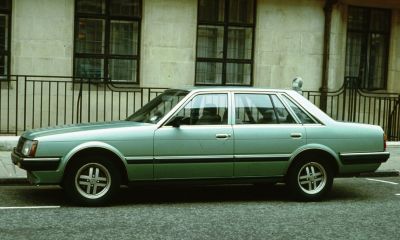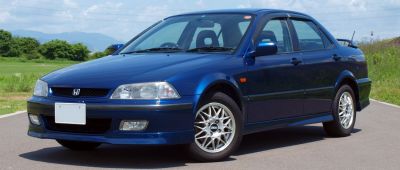 1994 Toyota Vista (V40) Dimensions, Size & Specs
1994 Toyota Vista (V40) Dimensions, Size & SpecsMeasurements of the 1994 Toyota Vista, engineered for optimal performance and comfort
| Dimensions | |
|---|---|
| Length: | 4625-4640 mm182.1-182.7 in15.2-15.2 ft |
| Width: | 1695 mm66.7 in5.6 ft |
| Height: | 1395-1410 mm54.9-55.5 in4.6-4.6 ft |
| Weight Specifications | |
| Curb Weight: | 1150-1250 kg2535-2756 lbs |
| Maximal permitted Weight: | 1425-1525 kg3142-3362 lbs |
| Tire Specifications | |
| Rims Size: |
|
| Tire Size: |
|
The Toyota Vista V40 generation, produced from 1994 to 1998, is a mid-size sedan known for its practical dimensions and balanced performance. Measuring between 4625 mm (182.1 inches) and 4640 mm (182.7 inches) in length, the Vista V40 offers a spacious yet maneuverable footprint suitable for urban and suburban driving. Its width is consistent at 1695 mm (66.7 inches), providing ample cabin space without compromising ease of parking or highway stability. The height ranges from 1395 mm (54.9 inches) to 1410 mm (55.5 inches), enabling a low center of gravity that contributes to stable handling. The curb weight of the vehicle spans 1150 kg (2535 lbs) to 1250 kg (2756 lbs), reflecting a relatively lightweight construction that favors fuel efficiency and nimble driving dynamics. The Vista V40 can carry a maximum weight between 1425 kg (3141 lbs) and 1525 kg (3363 lbs), making it suitable for typical family or commuter needs. Equipped with 14-inch rims, the car uses 185/70 R14 S tires, which balance ride comfort with responsive road contact. These specifications highlight the Vista V40's role as a reliable and versatile sedan during the mid-1990s, offering a blend of comfort, size, and functionality for daily use.
Discover the standout features that make the 1994 Toyota Vista a leader in its class
Have a question? Please check our knowledgebase first.
The Toyota Vista (V40) sedan produced between 1994 and 1998 features an overall length ranging from 4625 mm to 4640 mm (approximately 182.1 to 182.7 inches). This slight variation in length depends on the specific model variant and equipment configurations. The length places the V40 in the midsize category, providing ample cabin and trunk space without being too large for urban driving environments.
The width of the Toyota Vista (V40) is consistently 1695 mm, which converts to about 66.7 inches. This moderate width offers a good balance between interior shoulder room for passengers and maneuverability on narrower roads or in tight parking spaces. The width ensures a comfortable cabin environment without the bulk of larger sedans, maintaining the car's agility and ease of driving.
Height for the Toyota Vista (V40) ranges from 1395 mm to 1410 mm, or roughly 54.9 to 55.5 inches. This slight difference is due to variations in suspension setup or optional equipment like roof racks. The relatively low roofline contributes to better aerodynamic performance and a sporty silhouette while still providing adequate headroom inside the cabin.
The curb weight for the Toyota Vista (V40) falls between 1150 kg to 1250 kg (approximately 2535 to 2756 pounds). This weight range is quite reasonable for a midsize sedan from the mid-1990s, offering a good compromise between structural rigidity and fuel efficiency. A lighter curb weight helps improve acceleration and handling, while also contributing to somewhat better fuel economy compared to heavier vehicles in the same class.
The Toyota Vista (V40) has a maximum weight capacity ranging from 1425 kg to 1525 kg, which is about 3140 to 3363 pounds. This figure includes the curb weight plus the weight of passengers, cargo, and any additional fluids or accessories. This capacity ensures the vehicle can safely accommodate full occupancy and typical luggage loads without compromising drivability or safety.
The Toyota Vista (V40) comes equipped with 14-inch rims paired with 185/70 R14 tires. Such tire dimensions provide a balanced ride quality, combining sufficient sidewall height for cushioning road irregularities with good road grip and handling stability. These specs are typical for midsize sedans of its era, offering a smooth and controlled driving experience.
Yes, the Toyota Vista (V40) typically fits comfortably into a standard residential garage. Standard single-car garages usually accommodate vehicles up to around 2400 mm (94.5 inches) wide and 5400 mm (213 inches) long. With its length of 4625-4640 mm (182.1-182.7 inches) and width of 1695 mm (66.7 inches), the Vista leaves ample clearance for opening doors and maneuvering within the garage space.
Compared to its predecessor from the early 1990s, the Toyota Vista (V40) is generally similar in width but slightly longer by approximately 50-100 mm (2-4 inches), providing extra cabin and trunk room. The V40's curb weight is slightly increased due to added safety features and stronger body construction, moving from around 1100-1200 kg to 1150-1250 kg (2425-2755 lbs), enhancing vehicle stability and ride comfort while maintaining relatively efficient fuel consumption.
The Toyota Vista (V40) fits within typical midsize sedan dimensions of its era, featuring a length around 4630 mm (182 inches) and width near 1695 mm (67 inches). When compared to competitors like the Honda Accord or Nissan Bluebird from the mid-90s, the Vista is slightly more compact but offers competitive curb weight ranging between 1150 to 1250 kg (2535 to 2756 lbs). This makes the V40 well-balanced in terms of maneuverability, passenger comfort, and fuel efficiency compared to its rivals.
The Toyota Vista (V40) comes exclusively as a sedan, which offers practical advantages such as a separate trunk for secure cargo storage and a well-defined passenger compartment. This body style enhances structural rigidity and provides better rear passenger comfort compared to hatchbacks. Moreover, the sedan's design is traditionally favored for professional and family use, combining a comfortable ride with an efficient layout.
Discover similar sized cars.

| Production: | 1967-1973 |
|---|---|
| Model Year: | 1968 |
| Length: | 4680 mm184.3 in |
| Width: | 1770 mm69.7 in |
| Height: | 1440 mm56.7 in |

| Production: | 1967-1973 |
|---|---|
| Model Year: | 1968 |
| Length: | 4680 mm184.3 in |
| Width: | 1770 mm69.7 in |
| Height: | 1440 mm56.7 in |

| Model Year: | 1973 |
|---|---|
| Length: | 4680 mm184.3 in |
| Width: | 1770 mm69.7 in |
| Height: | 1440 mm56.7 in |

| Production: | 1972-1976 |
|---|---|
| Model Year: | 1973 |
| Length: | 4680 mm184.3 in |
| Width: | 1770 mm69.7 in |
| Height: | 1440 mm56.7 in |

| Production: | 1981-1985 |
|---|---|
| Model Year: | 1981 |
| Length: | 4635 mm182.5 in |
| Width: | 1690 mm66.5 in |
| Height: | 1400 mm55.1 in |

| Production: | 1984-1989 |
|---|---|
| Model Year: | 1984 |
| Length: | 4710-5000 mm185.4-196.9 in |
| Width: | 1730-1750 mm68.1-68.9 in |
| Height: | 1425-1451 mm56.1-57.1 in |

| Production: | 1993-1999 |
|---|---|
| Model Year: | 1993 |
| Length: | 4645 mm182.9 in |
| Width: | 1715 mm67.5 in |
| Height: | 1380 mm54.3 in |

| Production: | 1997-2002 |
|---|---|
| Model Year: | 1997 |
| Length: | 4635-4680 mm182.5-184.3 in |
| Width: | 1695-1720 mm66.7-67.7 in |
| Height: | 1405-1420 mm55.3-55.9 in |
